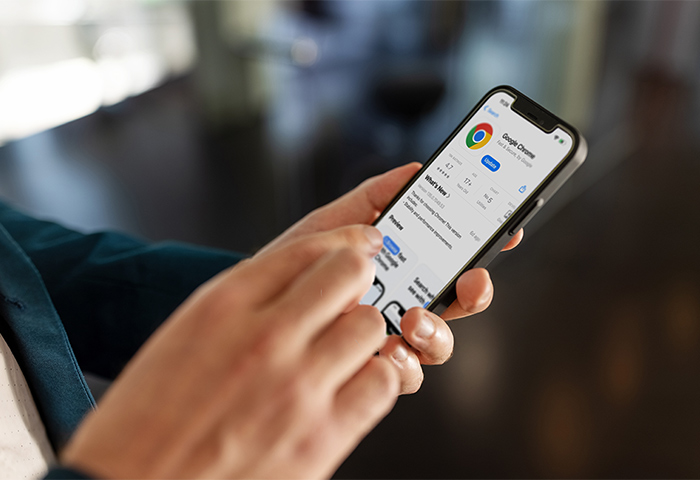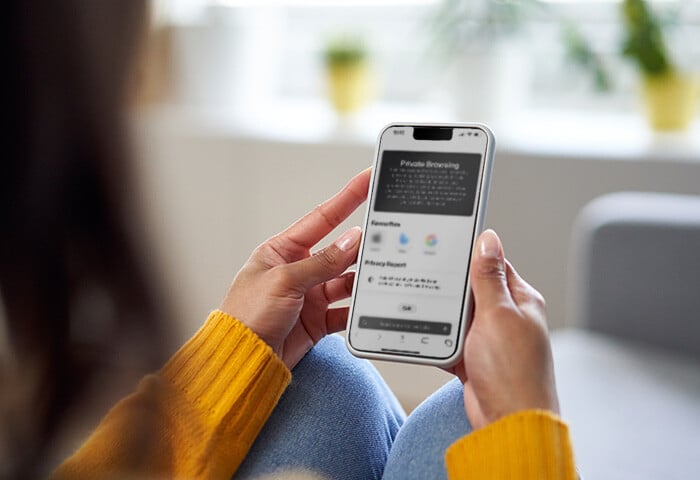How to block pop-ups on Chrome
Chrome, Safari, Firefox, and Edge may not be the most secure browsers, but they all have content settings that give you some control over your browsing experience. Here’s how to stop pop-ups on Chrome.
Block pop-up on all sites
You can turn on Google Chrome’s pop-up blocker using Chrome’s pop-up settings.
-
Open the Chrome browser, click the three dots in the upper-right corner, and then click Settings.
/img_01.png?width=450&name=img_01.png)
-
Click Privacy and security in the left-side navigation menu.
/img_02.png?width=1284&name=img_02.png)
-
Select Site settings at the top of the page.
/img_03.png?width=1613&name=img_03.png)
-
Scroll down and click Pop-ups and redirects.
/img_04.png?width=1053&name=img_04.png)
-
Toggle Blocked (recommended) to on. (It’s off in the screenshot below.)
/img_05.png?width=1352&name=img_05.png)
Chrome’s built-in pop-up blocker will handle many of the pop-ups you encounter on the web. They’re not just annoying, they can be dangerous — some pop-ups contain malicious software. To thoroughly clean up your browser, use an ad blocker. Unfortunately, blocking pop-ups won’t do anything about ads that are displayed within web pages.
Another way to comprehensively block pop-ups is to use a secure web browser that can manage everything for you, like the free AVG Secure Browser. Get automatic pop-up and ad blocking, powerful anti-tracking features, HTTPS encryption, and more.
Block pop-ups on a specific site
Fine-tune your browsing experience by blocking pop-ups on specific sites. Some websites use pop-ups for login forms or other necessary procedures, and you might want to continue to see those. So, by blocking pop-ups only on specific websites, no other sites will be affected.
-
Follow Steps 1 to 4 above.
-
If the site you want to block pop-ups from is on the Allow list, click the three dots next to that website’s name and select Block in the drop-down menu.
/img_06.png?width=1057&name=img_06.png)
-
If the site you want to block pop-ups from isn’t on the Block or Allow lists, click the Add button next to the Block list.
/img_07.png?width=1407&name=img_07.png)
-
Enter the website’s URL, then click Add.
/img_08.png?width=1254&name=img_08.png)
If you’re already on a website and want to block the pop-ups you’re seeing there, you can also access the Chrome pop-up blocker settings directly from the address bar in your browser.
Click the lock icon on the left side of the address bar and click Site Settings from the menu. Then, proceed as outlined above.
/img_09.png?width=600&name=img_09.png) Are a bunch of add-ons or plugins bogging down your browser? Check out our complete guide to managing extensions in Chrome.
Are a bunch of add-ons or plugins bogging down your browser? Check out our complete guide to managing extensions in Chrome.
How to stop pop-ups on Android
For better or worse, pop-ups aren’t limited to desktop computers — you can also block or allow Chrome pop-ups on your Android phone or tablet.
Here’s how to stop pop-ups on Android:
-
Open up Chrome on your Android device.
-
Tap the three dots in the right corner and tap Settings.
/img_10.png?width=380&name=img_10.png)
-
Scroll down and choose Site settings.
/img_11.png?width=380&name=img_11.png)
-
Tap Pop-ups and redirects.
/img_12.png?width=380&name=img_12.png)
-
Toggle the slider to allow or block pop-ups in Chrome on Android.
/img_13.png?width=380&name=img_13.png)
Use other browsers besides Chrome? You can also learn how to block pop-ups on Safari, how to manage pop-ups in Firefox.
How do I know which pop-ups to block?
As a general rule, you should block pop-ups on any websites you don’t know and trust, especially any sites without HTTPS encryption. If a website’s URL begins with HTTP and not HTTPS, then your connection to that site is not secure.
Our recommended approach is to block all pop-ups, then make individual exceptions for websites that you know and trust — such as your bank. Many sites use pop-ups for helpful reasons, such as logging in, submitting a form, or watching a video. You’ll need to allow pop-ups on those sites to take advantage of these functions.
Blocking all pop-ups by default will speed up your browser, as can regularly clearing your cache and deleting your search history. A comprehensive browser cleaner tool will automate the process so you never need to worry about it yourself.
Are Chrome pop-ups dangerous?
Some pop-ups on Chrome are used to spread viruses or other malware, and clicking these pop-ups may install malware on your computer or bring you to malicious websites. Look out for the following warning signs of spam pop-ups:
-
The pop-up moves around: Jiggling pop-ups make it hard to click the close button. The pop-up designer hopes that you’ll accidentally click the pop-up instead.
-
The cancel or close button is super obvious: Some pop-up designers create fake buttons to fool you into clicking them. Look for the actual X icon that closes the window. On Windows, the keyboard shortcuts Ctrl + W or Alt + F4 will close the pop-up.
-
The pop-up claims to have detected malware on your computer: This is called scareware. There are no viruses on your computer, and if you click the pop-up, you’ll be asked to pay for fake antivirus software — which might actually be malware itself.
-
You’re suddenly seeing more pop-ups than usual: Adware is a type of malware that constantly spams you with pop-ups. Scan your system with a powerful adware removal tool to get rid of the infection.
Since some pop-ups can be dangerous, it’s important to allow only pop-ups from known and trusted websites.
To more fully protect yourself against online threats like malicious pop-ups, try the free AVG Secure Browser. It’s got ad blocking, tracker blocking, and pop-up blocking built right in, so you’ll never see a deceptive pop-up while you browse.
How to allow Chrome pop-ups
Now let’s learn how to enable all pop-ups on Chrome, and then how to allow pop-ups on Chrome only from specific websites you trust.
How to disable the pop-up blocker on Chrome
Google Chrome’s pop-up blocker is usually enabled by default. Here’s how to turn off Chrome’s built-in pop-up blocker:
-
Open the Chrome browser, click the three dots in the upper-right corner, and then click Settings.
/img_01.png?width=450&name=img_01.png)
-
Click Privacy and security in the left-side navigation menu.
/img_02.png?width=1284&name=img_02.png)
-
At the top of the page, click Site settings.
/img_03.png?width=1613&name=img_03.png)
-
Scroll down and click Pop-ups and redirects.
/img_04.png?width=1053&name=img_04.png)
-
Toggle Blocked (recommended) to off.
/img_05.png?width=1352&name=img_05.png)
Allow Pop-ups on all sites
Some websites use pop-ups for reasons other than advertising. Rather than turn these pop-up notifications on one-by-one as you encounter them, let all websites show you pop-ups by following the same steps we described for disabling the pop-up blocker on Chrome.
Enable pop-ups on specific sites
Here’s how to allow pop-ups on specific websites you know and trust:
-
Follow thefirst four steps above (in How to disable the pop-up blocker on Chrome).
-
Under the Block category, find the site you want to allow pop-ups from.
-
Click the three dots to the right of the web address.
-
Click Allow in the drop-down menu.
-
To add a new website to your allow list, click Add next to the Allow section and then enter that website’s URL.
/img_05-2.png?width=664&name=img_05-2.png)
Avoid pop-ups and browse faster with AVG Secure Browser
Chrome and other browsers have a number of settings that let you allow or block pop-ups as needed. But a privacy-focused browser like AVG Secure Browser blocks pop-ups and other harmful online content automatically, because it’s been designed with security and privacy at the forefront.
/img_14.png?width=1289&name=img_14.png) AVG Secure Browser’s suite of security and privacy features.
AVG Secure Browser’s suite of security and privacy features.
AVG Secure Browser blocks ads, pop-ups, and web trackers to protect your privacy, repel malicious ads, and speed up your browsing.
Keep your data safe with automatic HTTPS encryption, protection against phishing attacks, and a built-in password manager.
You’ll also get seamless integration with other AVG security apps, like our flagship AVG AntiVirus FREE and AVG Secure VPN. And on your Android phone, you’ll enjoy a free VPN connection when you install AVG Secure Browser.
Protect your privacy, secure your personal data, and never see another unwanted pop-up again.
/Signal-How-to-allow-and-block-pop-ups-in-Chrome-Hero.jpg?width=1200&name=Signal-How-to-allow-and-block-pop-ups-in-Chrome-Hero.jpg)
/img_01.png?width=450&name=img_01.png)
/img_02.png?width=1284&name=img_02.png)
/img_03.png?width=1613&name=img_03.png)
/img_04.png?width=1053&name=img_04.png)
/img_05.png?width=1352&name=img_05.png)
/img_06.png?width=1057&name=img_06.png)
/img_07.png?width=1407&name=img_07.png)
/img_08.png?width=1254&name=img_08.png)
/img_09.png?width=600&name=img_09.png) Are a bunch of add-ons or plugins bogging down your browser? Check out our complete guide to
Are a bunch of add-ons or plugins bogging down your browser? Check out our complete guide to /img_10.png?width=380&name=img_10.png)
/img_11.png?width=380&name=img_11.png)
/img_12.png?width=380&name=img_12.png)
/img_13.png?width=380&name=img_13.png)
/img_05-2.png?width=664&name=img_05-2.png)
/img_14.png?width=1289&name=img_14.png) AVG Secure Browser’s suite of security and privacy features.
AVG Secure Browser’s suite of security and privacy features.













